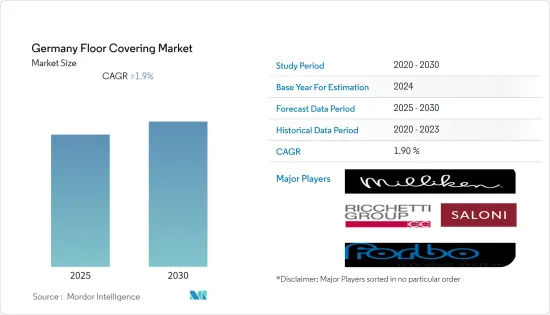
독일 바닥재 시장은 예측 기간 동안 1.9% 이상의 연평균 성장률(CAGR)을 기록할 것으로 예상됩니다.

독일은 서유럽 동맹의 바닥재 시장에서 큰 점유율을 차지하고 있습니다. 바닥재 시장은 성숙하고 조사 기간 동안 안정적인 성장을 기록했는데, 이는 경기 감속으로 부동산과 건설 활동이 침체했기 때문입니다. 이 시장은 보통 DIY(Do It Yourself)의 전통이 주도하는 개조가 주요 요인이 되고 있습니다. 따라서 대부분의 소비자 그룹은 설치가 쉽고 시간이 걸리지 않는 제품을 선호합니다. 온라인 전업 기업의 동향이 국내 유통 채널을 형성하고 있다고는 해도, 소비자의 대부분은 구입전에 전문가에게 이야기를 듣거나, 추천품을 통해 조언을 요구하거나, 실제로 제품을 보거나 하기 위해, 전문점에 가는 것을 좋아하기 때문에 점포에 가는 경향이 여전히 시장을 독점하고 있습니다. COVID-19는 업계가 경기의 상당한 감속을 경험하고 있기 때문에 바닥재 시장에 영향을 미치고 있으며, 예측 기간의 초기 몇 년간은 회복에 많은 시간이 걸릴 것으로 예측되고 있습니다. 이 동향은 영국이나 스페인 등 다른 서유럽 주요 국가에서도 마찬가지라고 예측됩니다. 독일의 바닥재 시장은 고품질 제품의 다양한 포트폴리오를 가진 여러 주요 기업이 존재하기 때문에 단편화되었습니다. 보고서에 설명된 일부 주요 기업들은 유럽 연합 전체, 특히 서유럽에서 높은 시장 점유율을 차지합니다.
독일 건설 산업은 계속 성장하고 있으며 유럽 연합에서 가장 큰 점유율을 차지합니다. 이 부문의 수익은 전년 대비 평균 1.8%의 성장률을 기록하고 있습니다. 틈새 분야, 예를 들어 음향 및 조립식 건축 시스템의 분야에서 높은 전문성은 시장 성장을 뒷받침하고 국가 전체의 바닥재 시장을 견인하고 있습니다. 이 산업은 2015년 동안 주택 및 비주택 건축물의 건설에서만 6,000만 달러의 수익을 올렸으며, 점점 더 많은 수익을 기록하고 있습니다.
독일에서는 조사 기간 동안 기존의 바닥재로부터 큰 변화가 보였습니다. 고령화 인구가 점점 증가함에 따라 젊은 세대는 보다 현대화된 솔루션을 찾게 되었습니다. 인테리어에 익숙해지기 쉽고 선명한 색상의 조합은 더욱 중요해지고 있습니다. 또한 예측 기간 동안 성장할 것으로 추정됩니다. 독일 사회의 진화에 따라, 특히 카펫과 같은 바닥재에 대한 관심이 현저하게 떨어지고 있습니다. 또한 나무 바닥재 부문은 마이너스 성장 추세를 기록했습니다.
이 보고서는 독일에서 사업을 전개하는 주요 기업의 경쟁 구도를 다룹니다. 이 시장의 주요 기업의 대부분은 세계적으로 사업을 전개하고 많은 유럽 국가에서 강력한 시장을 가지고 있습니다. 독일의 바닥재 시장은 급속히 변화하는 기술의 진보의 도움으로 생산 능력을 높이기 위해 다양한 전략을 채택하여 업계를 선도하는 기업의 조합입니다.
The Germany Floor Covering Market is expected to register a CAGR of greater than 1.9% during the forecast period.

Germany constitutes a major share in the floor covering market in the Western European Union. The market for floor coverings is mature and recorded stable growth during the study period, owing to the slowdown of economy, which led to weak real estate and construction activities. The market is majorly driven by refurbishments, which are usually led by do it yourself (DIY) traditions. Thus, the majority consumer group prefers products that are easy to install and do not involve more timelines. Even though a progression of dedicated online players is shaping the distribution channel in the country, a trend of going to the store is still dominating the market, as most consumers are still preferring going to a specialist store, in order to speak to an expert to seek help through recommendations and to physically witness the product before making a purchase. Due to COVID-19, the industry is experiencing a strong slowdown in the economy, thus affecting the market for floor coverings, and it is estimated to take much time to recover during the initial years of the forecast period. This trend is projected to be the same in the other major Western European countries, like the United Kingdom and Spain. The floor covering the market in Germany is fragmented, due to the presence of several key players with a diversified portfolio of high-quality products. Several key players mentioned in the report accounted for a high market share across the European Union, especially in the Western Europe.
The construction industry in Germany has been growing and contributes the largest share in the European Union. The revenue from the sector is recording an average growth rate of 1.8% year on year. The high level of specialization in niches, for example, the fields of acoustic and prefabricated construction systems are helping the market to grow, and they are driving the market for floor covering across the country. The industry generated USD 60 million alone from the construction of residential and non-residential buildings during 2015, and it has been recording increasing shares of revenue.
A major shift from the traditional floor coverings was observed in Germany during the study period. With the gradual increase in the aging population, the younger generation is looking for more modernized solutions. The vibrant color combinations, which easily get on with the interiors, are gaining more significance. Furthermore, they are estimated to grow during the forecast period. With the evolving German society, there is significant loss of interest, especially in flooring types, such as carpets. Furthermore, the wooden flooring segment recorded a negative growth trend.
The report covers the competitive landscape of the major players operating in the country. Most of the key players of the market have a global presence and a strong market in many of the European countries. The floor covering market in Germany is a combination of players who are leading the industry by adopting various strategies, in order to increase their production capacities with the help of rapidly changing technology advancements.